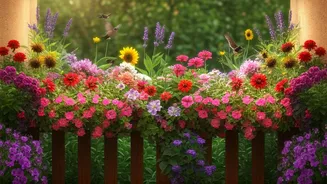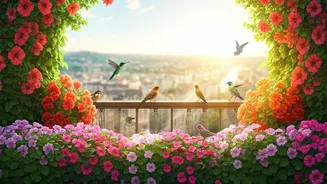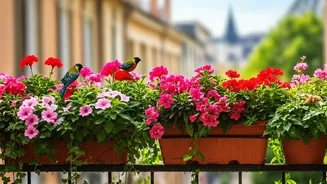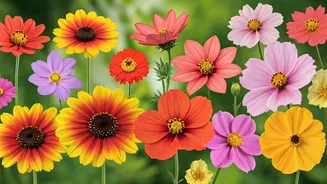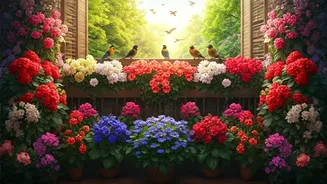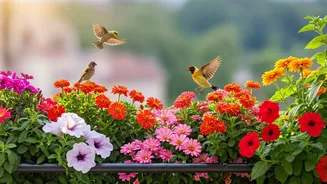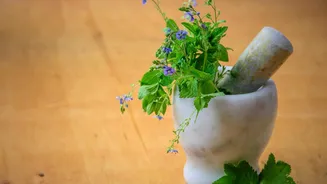Bird-Friendly Blooms
Attracting birds to a balcony garden involves selecting flowers that provide both visual appeal and a source of sustenance. Consider plants that produce
nectar, seeds, or attract insects, which serve as a natural food source for various bird species. The presence of colorful flowers such as Zinnias and Marigolds, which also provide a variety of food sources, adds vibrancy and life, making the balcony an inviting space for birds. Additionally, offering water sources, such as a shallow dish, further encourages bird visits. Providing shelter, like small shrubs, helps birds feel secure and offers nesting opportunities. Creating a bird-friendly balcony requires a holistic approach, carefully selecting plants and providing the elements necessary to support bird life, encouraging the birds to make your balcony their home, adding song and color to your outdoor space. Careful consideration of sunlight and shade patterns is crucial, as is choosing flowers that thrive in your local climate. This ensures long-term success and enjoyment of your bird-filled balcony haven.
Zinnias: A Splash of Color
Zinnias are renowned for their vibrant colors and ability to attract butterflies and hummingbirds, making them an excellent choice for any balcony garden. These flowers bloom profusely throughout the warmer months and are relatively easy to maintain. Zinnias offer a variety of sizes and hues, allowing for creative arrangements and color combinations. Ensure they receive ample sunlight, ideally at least six hours daily, to promote healthy growth and abundant flowering. Regular watering, especially during dry spells, is essential, but be cautious not to overwater, as this can lead to root rot. Zinnias are adaptable and thrive in various soil conditions, as long as the drainage is good. Deadheading, or removing spent blooms, encourages continuous flowering, prolonging the visual appeal and benefit to birds. Planting zinnias not only introduces color but also contributes to the biodiversity of your balcony garden, providing nectar for various species and creating a dynamic ecosystem.
Marigolds: Pest-Repellent Beauty
Marigolds are known for their bright, cheerful appearance and their ability to repel certain pests, adding a layer of protection to your balcony garden. These flowers are relatively low-maintenance, making them a great option for beginner gardeners. They thrive in full sun and well-draining soil, requiring moderate watering. Marigolds come in various shades of yellow, orange, and red, providing a vibrant display and contrasting beautifully with other plants. Their pungent scent also helps deter common garden pests. Marigolds are not only attractive to the eye, but also serve a practical purpose in a balcony garden by helping to minimize the use of chemical pesticides. Furthermore, their bright colors provide a visual cue to attract birds and beneficial insects, further enhancing the garden’s ecosystem. The introduction of marigolds enhances the attractiveness of the garden and creates a healthier, more balanced environment for both plants and the birds that visit.
Petunias: Trailing Elegance
Petunias, with their cascading blooms and diverse color palette, are ideal for adding elegance and drama to a balcony garden. They can be planted in hanging baskets or containers, creating a lush, flowing effect. Petunias thrive in sunlight but may need some afternoon shade in hotter climates. Regular watering is key, but avoid getting the foliage wet to prevent fungal diseases. Deadheading spent flowers will encourage more blooms, extending their display throughout the growing season. The various colors of petunias allow for creative combinations, complementing other flowers and enhancing the balcony's overall aesthetic. These versatile plants also attract hummingbirds and butterflies, bringing additional life and movement to your space. By carefully tending to petunias, you create a captivating display that benefits both the eye and the local bird population, making your balcony a welcoming haven for all.
Nasturtiums: Edible Delights
Nasturtiums offer a unique combination of beauty and functionality, as their flowers and leaves are edible, adding a delightful touch to your balcony garden. These plants are relatively easy to grow and thrive in a variety of conditions, preferring full sun but tolerating partial shade. They are known for their vibrant, trumpet-shaped flowers, which come in shades of orange, yellow, and red. Nasturtiums require moderate watering and well-drained soil. They can be used in salads or as a garnish, adding a peppery flavor. The flowers also attract hummingbirds and beneficial insects. Growing nasturtiums in your balcony garden adds beauty and provides a practical element, offering an edible treat. Their ability to attract pollinators further enhances your garden's ecosystem. The presence of nasturtiums makes your balcony a diverse and interesting space.
Sunflowers: Miniature Giants
Even in a compact space, sunflowers can bring a touch of the countryside to your balcony garden. Miniature varieties are ideal for containers, producing bright yellow blooms that attract birds. These plants love sunlight and require consistent watering. Sunflowers are known for their cheerful appearance, adding height and visual interest to the garden. Ensure they have adequate space and support, if needed, as they can grow quite tall. As the sunflower heads mature, they produce seeds, providing a natural food source for birds, especially during the fall. Including sunflowers creates a dynamic environment, encouraging birds and providing a vital food source. Their presence also boosts the garden's visual appeal and ecosystem, providing a sense of natural beauty and contributing to the overall wellbeing of your balcony space.
Lavender: Fragrant Attraction
Lavender not only adds a soothing fragrance to your balcony but also attracts bees and butterflies, indirectly benefiting birds. This plant thrives in sunny locations and well-drained soil. Lavender is relatively drought-tolerant, so it doesn’t require frequent watering. Its purple flowers and silvery foliage add a touch of elegance to any garden. The scent of lavender is known for its calming properties. While the flowers themselves may not directly feed birds, the presence of bees and butterflies that it attracts provides a food source for some birds. Growing lavender on your balcony creates a serene environment. It supports biodiversity, contributes to a pleasant sensory experience, and enhances the appeal of your outdoor space.
Coneflowers: Pollinator Haven
Coneflowers, also known as Echinacea, are excellent for attracting pollinators, which in turn benefit the birds that may visit your balcony. These daisy-like flowers come in various colors, providing visual interest. Coneflowers are relatively easy to care for, thriving in full sun and well-drained soil. Regular watering is needed, particularly during dry spells. They produce seeds that provide a food source for birds in the fall. Coneflowers are resilient plants that add beauty and contribute to a healthy ecosystem. Their ability to attract a variety of pollinators increases the likelihood of bird visits, making your balcony a dynamic and lively habitat. Planting coneflowers contributes to both the visual appeal of your balcony and helps in creating a balanced and biodiverse environment.
Bee Balm: Hummingbird Magnet
Bee balm, or Monarda, is a true hummingbird magnet, making it a valuable addition to your bird-friendly balcony garden. This plant features vibrant, fringed flowers in shades of red, pink, and purple. Bee balm thrives in full sun and moist, well-drained soil. Regular watering and deadheading encourage prolonged blooming. Its nectar-rich flowers are irresistible to hummingbirds, bringing vibrant energy to your balcony space. This plant also attracts bees and butterflies, further enriching the garden's ecosystem. Growing bee balm creates an environment with continuous activity and entertainment. Its presence transforms your balcony into a bustling, colorful habitat, offering a unique and engaging experience.
Pansies: Seasonal Color
Pansies are a great choice for adding seasonal color to your balcony garden, and their presence indirectly benefits birds by contributing to a diverse and attractive environment. These colorful flowers come in various hues and patterns. Pansies prefer cooler temperatures and thrive in partial shade. Regular watering and deadheading are essential to promote continuous blooming. While they may not directly feed birds, their bright colors and attractive appearance create a welcoming space. Pansies add charm and beauty, encouraging a lively atmosphere, and enhancing the overall aesthetics of your balcony. They contribute to a visually pleasing environment that can be enjoyed by both you and the potential bird visitors, bringing a touch of cheerfulness to your outdoor space during the cooler months.
